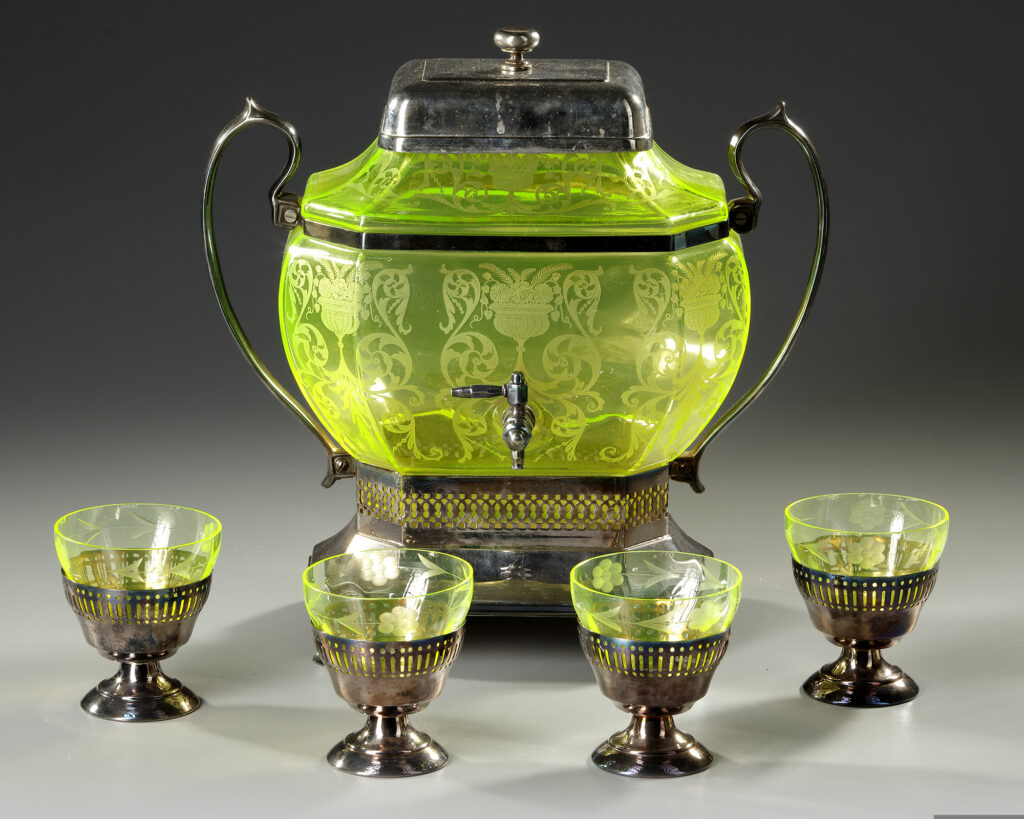Brief introduction to uranium glassware
Certainly! Here’s a detailed introduction to uranium glassware:
Introduction to Uranium Glassware
Uranium glassware, also known as Vaseline glass due to its resemblance to the color of Vaseline petroleum jelly under certain lighting conditions, is a unique and captivating category of glass collectibles. What sets uranium glass apart from other types of glassware is its distinctive green or yellow fluorescence when exposed to ultraviolet (UV) light. This effect, often referred to as “UV-reactive” or “glowing,” is caused by the uranium oxide content added during the glassmaking process.
Historically, uranium glass gained popularity during the late 19th and early 20th centuries, primarily in Europe and the United States. Its characteristic glow fascinated consumers and became a sought-after feature in decorative items, tableware, and even jewelry. While the use of uranium in glass production declined significantly after World War II due to safety concerns and regulatory restrictions, antique and vintage uranium glassware remains highly collectible today.
Beyond its aesthetic appeal, uranium glassware holds a significant place in the history of glassmaking and scientific discovery. The incorporation of uranium oxide not only influenced the glass’s visual properties but also contributed to advancements in understanding radiation and fluorescence. Today, uranium glass continues to intrigue collectors, historians, and scientists alike, serving as a tangible link to a bygone era of craftsmanship and scientific curiosity.
In this blog post, we will delve deeper into the allure of uranium glassware, exploring its history, unique aesthetic qualities, practical uses, and tips for collectors. Whether you’re a seasoned collector or a newcomer to the world of vintage glassware, join us on a journey to uncover the radiant elegance of uranium glass
.

“Mention its historical significance and popularity in the past and present”
Uranium glassware holds significant historical importance as a distinctive category of glass collectibles. Originating in the mid-19th century, its popularity surged during the Victorian era and into the early 20th century, driven by its unique fluorescence when exposed to UV light. This characteristic made uranium glassware highly desirable among affluent consumers, who prized its luminous green or yellow hues in decorative items and tableware. Beyond its aesthetic appeal, the incorporation of uranium oxide in glassmaking marked a period of technological innovation and scientific curiosity, contributing to early experiments in radiation detection and fluorescence studies. In contemporary times, while production has waned due to safety concerns, uranium glassware remains highly coveted among collectors for its rarity and historical significance. Its enduring allure continues to attract interest from historians, collectors, and enthusiasts, serving as a tangible link to a bygone era of craftsmanship and scientific discovery.

“Popular periods and countries of production”
Uranium glassware experienced notable production periods and was manufactured primarily in several key countries. During its peak popularity from the late 19th century through the early 20th century, the production of uranium glassware flourished in Europe, particularly in countries like England, Czechoslovakia (now Czech Republic), and Germany. These regions were known for their skilled glassmakers who embraced the addition of uranium oxide to create the distinctive fluorescent properties that set uranium glass apart. In the United States, production also thrived during this period, with companies such as Fenton, Northwood, and Cambridge Glass contributing significantly to the market. Each country developed its own styles and techniques, resulting in a diverse array of uranium glassware designs that catered to varying tastes and preferences. Collectors today often seek out pieces from these historical periods and regions, appreciating their craftsmanship and the cultural contexts in which they were produced.
CODE : SAQIB878765
Tips for identifying uranium glass
Identifying uranium glass, also known as Vaseline glass, requires attention to specific characteristics due to its unique properties. One of the most distinctive features is its fluorescence under UV light, typically emitting a green or yellow glow. When examining a piece, use a UV light source to observe this effect, which is a clear indicator of its uranium content. However, not all uranium glass glows brightly; some may exhibit a more subtle fluorescence. Additionally, uranium glass often has a slight tint of green or yellow in normal lighting conditions, though this can vary depending on the glass’s thickness and composition. Another method to confirm uranium glass is by using a Geiger counter, as uranium emits low-level radiation that can be detected. However, caution should be exercised with older pieces due to safety concerns regarding prolonged exposure to radioactive materials. Finally, familiarizing oneself with the specific patterns and shapes produced by prominent manufacturers during the height of uranium glass production can also aid in identification. These tips collectively assist collectors and enthusiasts in confidently identifying and appreciating the allure of uranium glass.
Encourage readers to explore and appreciate this unique collectible
Exploring and appreciating uranium glass offers a captivating journey into both artistic craftsmanship and scientific curiosity. Each piece of uranium glassware tells a story of innovation and historical significance, showcasing the intricate blending of artistry with the scientific application of uranium oxide. By delving into the world of uranium glass, enthusiasts can uncover unique designs, patterns, and colors that reflect the cultural trends and technological advancements of their time. Moreover, understanding the properties of uranium glass, such as its fluorescence under UV light, adds an element of wonder and discovery to collecting. Whether you’re drawn to its radiant glow, its historical context, or its role in scientific experimentation, uranium glass invites you to appreciate its beauty from both aesthetic and educational perspectives. Embracing this unique collectible allows one to not only build a collection of striking glassware but also to connect with a rich legacy of craftsmanship and innovation that continues to fascinate collectors and historians alike.

Final thoughts on its enduring popularity and future prospects
“Final thoughts on its enduring popularity and future prospects” typically refers to a concluding reflection or analysis on why something (such as a product, trend, or concept) has remained popular over time and what its potential outlook is in the future.
Here’s how you might break down and explain this phrase:
- Enduring Popularity: This part of the phrase suggests looking into the reasons why something has maintained its popularity over an extended period. This could include factors such as:
- Utility: How useful or practical the item or concept is.
- Quality: Its level of excellence or superiority compared to alternatives.
- Cultural Relevance: How well it aligns with current societal trends or values.
- Nostalgia: The sentimental or emotional attachment people have to it.
- Innovation: Continual updates or improvements that keep it
